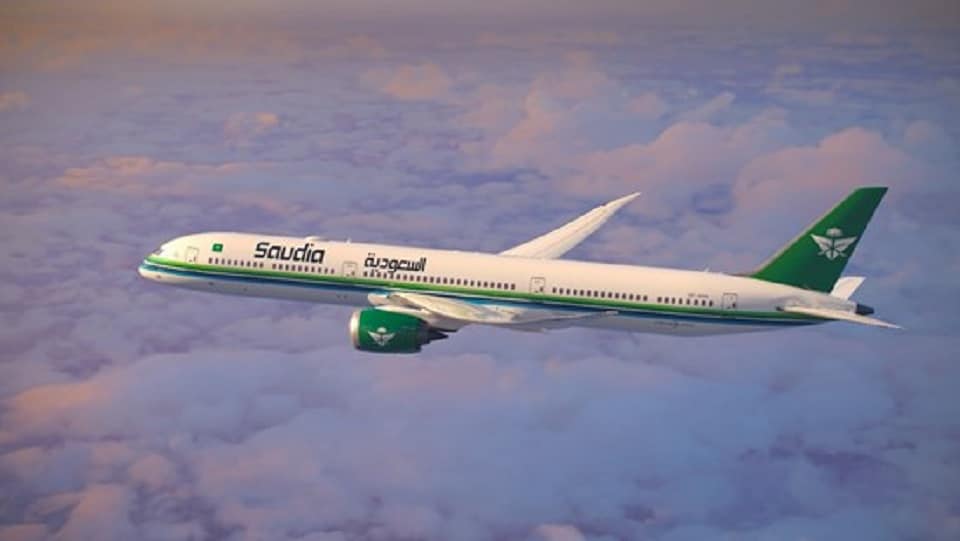Aerospace
Saudia Enters a New Era Through Major Re-Brand Strategy

Jeddah, Saudia, the national flag carrier of Saudi Arabia, revealed its new brand identity and livery during a milestone event in Jeddah, in the presence of Royal Highnesses, Excellencies, and leaders from both the public and private sectors, as well as prominent media correspondents and aviation experts. This new identity is in line with a wider strategic digital transformation plan aimed at strengthening the airline’s support for the Kingdom’s Vision 2030 to bring the world to Saudi Arabia.
The new brand color identity, comprised of green, blue, and sand, represents Saudia’s aim to expand its fleet and destinations, connecting the world to Saudi Arabia, and emphasizing the Kingdom’s authenticity and deep-rooted values.
In parallel to the rebrand, Saudia has also undertaken a huge digital transformation, entirely enhancing the customer digital experience. Saudia leads among international airlines in operating generative Artificial Intelligence (AI) as a virtual assistant, named “SAUDIA”, being one of the first of its kind in the region. Saudia will enable guests to complete the entire transaction through this efficient process by the end of the year.
The ambitious, long-planned digital transformation, fully improves customer experience but also allow more streamlined operations and processes while ensuring the highest levels of protection of guests’ personal data, through strong partnerships with global leading companies.
His Excellency Engr. Ibrahim Al-Omar, Director General of Saudia Group, said: “We are experiencing a new era and a very exciting time for Saudia. Our airline has evolved from a Douglas DC-3 aircraft in 1945, to a 140-aircraft modern fleet serving over 100 destinations, becoming one of the largest airline in the region.
The name and logo of Saudia are integral parts of the Kingdom’s aviation history and development, and our people share a special emotional connection with the brand. We have incorporated this rich heritage into our new identity, adding elements that reflect our visionary approach, poised to captivate the world.”
Saudia is not only rolling out a fully integrated digital program and revamping its look, it is also effectively and quickly helping advance Saudi Arabia’s Vision 2030, collaborating with all industry stakeholders to achieve the targets of the National Aviation Strategy. The strategy aims to turn Saudi Arabia into a leader in the global industry, by enhancing the customer experience, improving safety and working towards a more sustainable future, in line with Saudia’s expansion goals to bring around 330 million visitors to the Kingdom by 2030.

Aerospace
Boeing Transfers Rocket Stage to NASA, Paving Way for Human Moon Mission

Boeing has achieved a significant milestone by providing NASA with the second core stage of the Space Launch System (SLS) rocket.
This crucial component, crafted at NASA’s Michoud Assembly Facility (MAF), is set to propel the Artemis II crew into lunar orbit, marking humanity’s return to deep space after a 50-year hiatus.
The monumental Boeing-built rocket stage, the largest element of the Artemis II mission, will embark on a journey aboard the Pegasus barge, traveling 900 miles to NASA’s Kennedy Space Center.
Comparison of two legendary aircraft B777x vs B747 aircraft:Click here
Upon arrival, it will be meticulously integrated with other essential Artemis II components, including the upper stage, solid rocket boosters, and NASA’s Orion spacecraft within the iconic Vehicle Assembly Building. This intricate integration process is a vital step toward the eagerly anticipated Artemis II launch, slated for 2025.
“Boeing-built products helped land humankind on the moon in 1969, and we’re proud to continue that legacy through the Artemis generation,” remarked Dave Dutcher, vice president and program manager for Boeing’s SLS program. “Together, with NASA and our industry partners and suppliers, we are building the world’s most capable rocket and paving the way to deep space through America’s rocket factory in New Orleans.”
NASA, Lockheed Martin Reveal X-59 Quiet Supersonic Aircraft:Click here
The delivery of Core Stage 2 marks a significant achievement in the evolution of the SLS rocket. Towering over 200 feet and powered by four RS-25 engines, this core stage, coupled with two solid-fueled booster rockets, will generate a staggering 8.8 million pounds of thrust. This immense power is crucial to launching Artemis II and future missions into the vast expanse of space.
The SLS rocket stands unparalleled in its capability to transport both crew and substantial cargo to the moon and beyond in a single launch. Its extraordinary capacity will facilitate the delivery of human-rated spacecraft, habitats, and scientific missions to destinations including the moon and Mars, ushering in a new era of space exploration.
-

 Travel1 week ago
Travel1 week agoAir India to Expand US Operations with Three New Routes After a Decade
-

 Travel2 weeks ago
Travel2 weeks agoWhy We Should Avoid These Stamps in a Passport
-

 Airlines1 month ago
Airlines1 month agoInvestigations Reveal Fake Chinese Titanium in Boeing and Airbus Jets
-

 Tech4 weeks ago
Tech4 weeks agoChina’s CATL Plans 1,800-Mile Electric Plane Launch by 2027
-

 Airport3 days ago
Airport3 days agoTop 10 Largest Airports in the World by Size
-

 Aerospace4 weeks ago
Aerospace4 weeks agoChina’s Fighter Jets Turn Wings into Autonomous Drones
-

 Airlines4 days ago
Airlines4 days agoAir India Rolls Out A350s for Delhi-New York JFK and Newark Routes
-

 Defence3 weeks ago
Defence3 weeks agoBoeing Enhances Chinook with New Engines and Block II Upgrades at $96 Million







